Free PDF Download of CBSE Chemistry Multiple Choice Questions for Class 12 with Answers Chapter 11 Alcohols, Phenols and Ethers. Chemistry MCQs for Class 12 Chapter Wise with Answers PDF Download was Prepared Based on Latest Exam Pattern. Students can solve NCERT Class 12 Chemistry Alcohols, Phenols and Ethers MCQs Pdf with Answers to know their preparation level.
Alcohols, Phenols and Ethers Class 12 Chemistry MCQs Pdf
1. The heating of phenyl methyl ether with HI produces
(a) Iodobenzene
(b) Phenol
(c) Benzene
(d) Ethyl chloride
Answer/Explanation
Answer: b
Explaination:

2. Which of the following gives positive iodoform test?

Answer/Explanation
Answer: c
Explaination:

3.
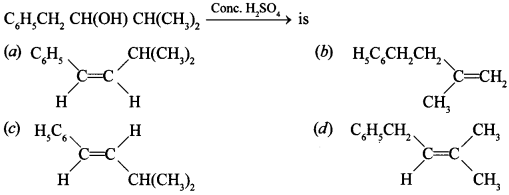
Answer/Explanation
Answer: c
Explaination:

4. CH3—O—CH (CH3)2 + HI → Products is/are

Answer/Explanation
Answer: d
Explaination:

5.
![]()
The product ‘Z’ is
(a) Benzaldehyde
(b) Benzoic acid
(c) Benzene
(d) Toluene
Answer/Explanation
Answer: b
Explaination:

6. Which one of the following compounds has the most acid nature?
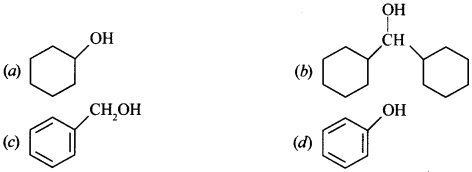
Answer/Explanation
Answer: d
Explaination:
(d) Phenol is most acidic in nature because phenoxide ion is stabilized by resonance.
7. Among the following sets of reactants which one produces anisole?
(a) CH3CHO : RMgX
(b) C6H5OH; NaOH, CH3I
(c) C6H5OH, neutral FeCl3
(d) C6H5 —CH3; CH3COCl; AlCl3
Answer/Explanation
Answer: b
Explaination:

8. The electrophile involved in Riemer-Tiemann reaction of phenol with CHCl3 in presence of NaOH
![]()
Answer/Explanation
Answer: a
Explaination:
![]()
9. Arrange the following in decreasing order of acidic character:

(a) IV > III > I > II
(b) II > IV > I > III
(c) I > II > III > IV
(d) III > I > II > IV
Answer/Explanation
Answer: d
Explaination:
(d) – Since, N02 and Cl are electron withdrawing but NO2 > Cl.
– OCH3 is more electron releasing due to +R effect than —CH3 group, therefore, IV is least acidic.
10.
![]()
(a) Etard reaction
(b) Gattermann Koch reaction
(c) Williamson synthesis
(d) Esterification
Answer/Explanation
Answer: c
Explaination:
(c) Williamson synthesis.
11. Identify ‘C’ in the following:

(a) Water
(b) Ethanol
(c) Propanone
(d) Cumene hydroperoxide
Answer/Explanation
Answer: c
Explaination:

12.
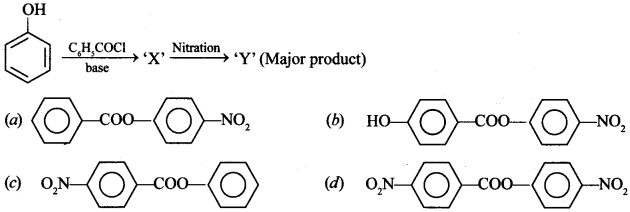
Answer/Explanation
Answer: a
Explaination:

13. Find the product of the given reaction:
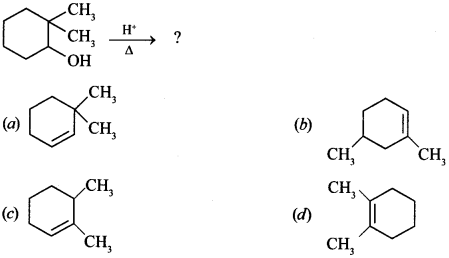
Answer/Explanation
Answer: a
Explaination:

14.

Answer/Explanation
Answer: b
Explaination:

15. Monochlorination of toluene in sunlight followed by hydrolysis with aq. NaOH yields. [NCERT Exemplar]
(a) o-Cresol
(b) m-Cresol
(c) 2, 4-Dihydroxytoluene
(d) Benzyl alcohol
Answer/Explanation
Answer: a
Explaination:

16. How many alcohols with molecular formula C4H10O are chiral in nature? [NCERT Exemplar]
(a) 1
(b) 2
(c) 3
(d) 4
Answer/Explanation
Answer: a
Explaination:

17. What is the correct order of reactivity of alcohols in the following reaction? [NCERT Exemplar]
![]()
(a) 1° > 2° > 3°
(b) P < 2° > 3°
(c) 3° > 2° > 1°
(d) 3° > 1° > 2°
Answer/Explanation
Answer: c
Explaination:
(c) 3° >2° > 1° is order of stability of carbocation .’. Reactivity follows the same order.
18. CH3CH2OH can be converted into CH3CHO by __________ . [NCERT Exemplar]
(a) catalytic hydrogenation
(b) treatment with LiAlH4
(c) treatment with pyridinium chlorochromate
(d) treatment with KMnO4
Answer/Explanation
Answer: c
Explaination:
![]()
19. IUPAC name of the compound

is _________ . [NCERT Exemplar]
(a) 1-methoxy-l-methylethane
(b) 2-methoxy-2-methylethane
(c) 2-methoxypropane
(d) isopropylmethyl ether
Answer/Explanation
Answer: c
Explaination:
(c) 2-methoxypropane
20. Which of the following species can act as the strongest base?

Answer/Explanation
Answer: b
Explaination:
(b) ∵ ROH is weakest acid,
∴ RO⊖ is strongest conjugate base.
21. The correct order of boiling point of primary (1°), secondary (2°) and tertiary (3°) alcohols is
(a) 1° > 2° > 3°
(b) 3° > 2° > 1°
(c) 2° > 1° > 3°
(d) 2° > 3° > 1°
Answer
Answer: a
22.
The above reaction is known as
(a) Williamson’s reaction.
(b) Hofmann’s synthesis.
(c) Mendies reaction,
(d) Darzen’s reaction.
Answer
Answer: d
23. The correct acidic strength order of the following

(a) I > II > III
(b) III > I > II
(c) II > III > I
(d) I > III > II
Answer
Answer: b
24. Which compound is predominantly formed when phenol is allowed to react with bromine in aqueous medium?
(a) Picric acid
(b) O-Bromophenol
(c) 2, 4, 6-Tribromophenol
(d) p-Bromophenol
Answer
Answer: c
25. Phenols are more acidic than alcohols because
(a) Phenoxide ion is stablised by resonance
(b) Phenols are more soluble in polar solvents
(c) Phenoxide ion does not exhibit resonance
d) Alcohols do not lose H atoms at all
Answer
Answer: a
26. The compound B is formed in the sequence of the reaction given below:
![]()
The compound B is
(a) Salicylaldehyde
(b) Benzoic acid
(c) Salicylic acid
(d) Cinnamic acid
Answer
Answer: c
27. Which of the following reagents cannot be used to distinguish between phenol and benzyl alcohol?
(a) FeCl3
(b) Litmus soln
(c) Br2/CCl4
(d) All of these
Answer
Answer: c
28. Identify Z in the series
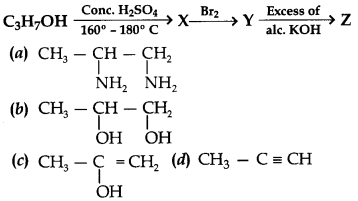
Answer
Answer: d
29. 1-propanol and 2-propanol can be best dis¬tinguished by
(a) Oxidation with KMnO4 followed by reaction with Fehling solution.
(b) Oxidation with acidic dichromate followed by reaction with Fehling solution.
(c) Oxidation by heating with copper followed by reaction with Fehling solution.
(d) Oxidation with concentrated H2SO4 followed by reaction with Fehling solution.
Answer
Answer: c
30. ![]()
In the above sequence Z is
(a) Toluene
(b) Cresol
(c) Benzene
(d) Benzol
Answer
Answer: c
31. The major organic product in the reaction, CH3 — O — CH(CH3)2 + HI → product: is/are
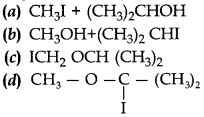
Answer
Answer: a
Note: In the following questions two or more options may be correct. (Q.21 to Q.23)
32. Which of the following are used to convert RCHO into RCH2OH? [NCERT Exemplar]
(a) H2/Pd
(b) LiAlH4
(c) NaBH4
(d) Reaction with RMgX followed by hydrolysis
Answer/Explanation
Answer:
Explaination:
(a), (b), (c) will convert RCHO into RCH2OH.
33. Which of the following reactions will yield phenol? [NCERT Exemplar]
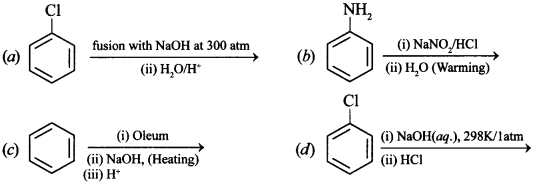
Answer/Explanation
Answer:
Explaination:
(a), (b), (c) will give phenol, (d) will not give phenol because high temperature is needed.
34. Which of the following reagents can be used to oxidise primary alcohols to aldehydes? [NCERT Exemplar]
(a) CrO3 in anhydrous medium.
(b) KMnO4 in acidic medium.
(c) Pyridinium chlorochromate.
(d) Heat in the presence of Cu at 573K.
Answer/Explanation
Answer:
Explaination:
(a), (c), (d) can be used. KMnO4 converts primary alcohol to carboxylic acids.
35. Match the structures of the compounds given in Column I with the name of the compounds given in Column II. [NCERT Exemplar]

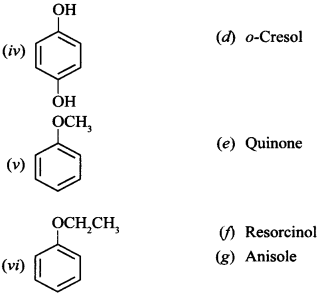
Answer/Explanation
Answer:
Explaination:
(i) (d) (ii) (c) (iii) (J) (iv) (a) or quinol (v) (g) (vi) (b)
36. Match the starting materials given in Column I with the products formed by these (Column II) in the reaction with HI. [NCERT Exemplar]

Answer/Explanation
Answer:
Explaination:
(i) (d) (ii) (e) (iii) (b) (iv) (a)
In cleavage of ethers, higher alcohol and lower alkyl halide is formed except in tert. butyl methyl ether, in which (CH3)3 C+ is more stable so (CH3)3C-I and CH3OH is formed. Anisole with HI gives phenol and CH3I because phenoxide ion is stabilised by resonance.
37. In the following question a statement of assertion followed by a statement of reason is given. Choose the correct answer out of the following choices.
(a) Assertion and reason both are correct and reason is correct explanation of assertion.
(b) Assertion and reason both are wrong statements.
(c) Assertion is correct statement but reason is wrong statement.
(d) Assertion is wrong statement but reason is correct statement.
(e) Both assertion and reason are correct statements but reason is not correct explanation of assertion.
Assertion: Bond angle in ethers is slightly less than the tetrahedral angle.
Reason: There is a repulsion between the two bulky (—R) groups. [NCERT Exemplar]
Answer/Explanation
Answer:
Explaination:
(d) Assertion is wrong statement but reason is correct statement.
38. Phenol reacts with Br2 in CS2 to give _________ as major product.
Answer/Explanation
Answer:
Explaination: p-bromophenol
39. Phenol gives o and p-nitrophenol with _________ .
Answer/Explanation
Answer:
Explaination: dil. HNO3
40. o-nitrophenol has _________ melting point than /j-nitrophenol.
Answer/Explanation
Answer:
Explaination: lower
41. Diethyl ether has dipole moment because they are bent molecule. [True/False]
Answer/Explanation
Answer:
Explaination: True
42. Ethers have lower boiling point than alcohol. [True/False]
Answer/Explanation
Answer:
Explaination:
True. It is due to weak van der Waals’ forces of attraction in ethers but intermolecular H-bonding in alcohol.
43. Dettol contains phenolic compound. [True/False]
Answer/Explanation
Answer:
Explaination: True, phenols are antiseptic in low concentration.
44. Write the IUPAC name of the given compound: [Foreign 2015]

Answer/Explanation
Answer:
Explaination: 3-methyl but-2-en-1-ol.
45. Write the IUPAC name of the given compound: [AI2015]

Answer/Explanation
Answer:
Explaination: 2-methyl propane 1, 3-diol.
46. Write the IUPAC name of the following compound: [Foreign 2012]

Answer/Explanation
Answer:
Explaination: Hex-4-en-3-ol.
47. Write IUPAC name of the following:

Answer/Explanation
Answer:
Explaination: 2, 2-Dimethyl propan-l-ol.
48. Write the IUPAC name of the following: [AI 2015 Bhubneshwar]

Answer/Explanation
Answer:
Explaination: l-Phenylpropan-2-ol.
49. Write IUPAC name of the compound: [Delhi 2015(C)]

Answer/Explanation
Answer:
Explaination: Butan-2-ol
50. Write IUPAC name of the given compound: [AI 2015 Patna]

Answer/Explanation
Answer:
Explaination: 2-methyl prop-2-en-l-ol.
51. Draw the structural formula of 2-methylpropan-2-ol molecule. [Delhi 2012]
Answer/Explanation
Answer:
Explaination:
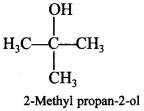
52. Draw the structure of hex-l-en-3-ol compound.
Answer/Explanation
Answer:
Explaination:

53. How is ethanol obtained from 2-butene? [Delhi 2012]
Answer/Explanation
Answer:
Explaination:

54. Write the IUPAC name of the given compound: [Delhi 2015]

Answer/Explanation
Answer:
Explaination: 2, 5-Dinitro phenol.
55. Write IUPAC name of the given compound: [AI 2015 Guwahati]

Answer/Explanation
Answer:
Explaination: 2, 4-Dimethyl phenol.
56. Draw the structure of 2, 6-dimethylphenol. [AI 2011]
Answer/Explanation
Answer:
Explaination:

57. Write the IUPAC name of the given compound: [AI 2015]

Answer/Explanation
Answer:
Explaination:

58. Write IUPAC name of the given compound: [AI 2015 Chennai and Trivandrum]

Answer/Explanation
Answer:
Explaination: 1-Methoxypropan-2-ol.
59. Write the structure of the following compound: 2-ethoxy-2-methyl pentane
Answer/Explanation
Answer:
Explaination:
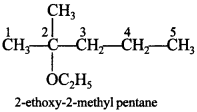
60. How is /-butyl alcohol obtained from acetone?
Answer/Explanation
Answer:
Explaination:

61. Write the chemical equation for the preparation of phenol from benzene using oleum and sodium hydroxide. [Delhi 2011(C)]
Answer/Explanation
Answer:
Explaination:

62. Why alcohols and phenols are soluble in water?
Answer/Explanation
Answer:
Explaination: This is due to their ability to form hydrogen bonds with water molecules.
63. Which of the following isomers is more volatile: o-nitrophenol or p-nitrophenol? [Delhi 2014]
Answer/Explanation
Answer:
Explaination: o-nitrophenol is more volatile, cone. H2SO4
64. How would you convert ethanol to ethene? [AI 2011]
Answer/Explanation
Answer:
Explaination:

65. Name a compound which is used as antiseptic as well as disinfectant.
Answer/Explanation
Answer:
Explaination:
0.2% solution of phenol is used as antiseptic, 2% solution of phenol is used as disinfectant.
66. Arrange the following in decreasing order of their acidic character: [Similar to AI 2017]
![]()
Answer/Explanation
Answer:
Explaination: (ii) > (iii) > (i)
67. Illustrate with examples the limitations of Williamson’s synthesis for the preparation of certain types of ethers.
Answer/Explanation
Answer:
Explaination:
Di-tertiary butyl ether cannot be prepared by Williamson’s synthesis because tertiary halides will undergo elimination reaction instead of substitution reaction.
68. What is the cause of large difference in boiling points of alcohols and ethers?
Answer/Explanation
Answer:
Explaination:
This is due to the presence of hydrogen bonding in alcohols but ether have weak van der Waals’ forces of attraction.
69. Convert anisole to p-bromoanisole. [Delhi 2015(C)]
Answer/Explanation
Answer:
Explaination:
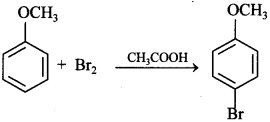
70. How will you synthesise the following from appropriate alkene: [Uttarakhand 2019]

Answer/Explanation
Answer:
Explaination:

71. Show how you will synthesise the following alcohol prepared by reaction of a suitable Grignard reagent on methanal? [Uttarakhand 2019]

Answer/Explanation
Answer:
Explaination:

We hope the given Chemistry MCQs for Class 12 with Answers Chapter 11 Alcohols, Phenols, and Ethers will help you. If you have any query regarding CBSE Class 12 Chemistry Alcohols, Phenols, and Ethers MCQs Pdf, drop a comment below and we will get back to you at the earliest.